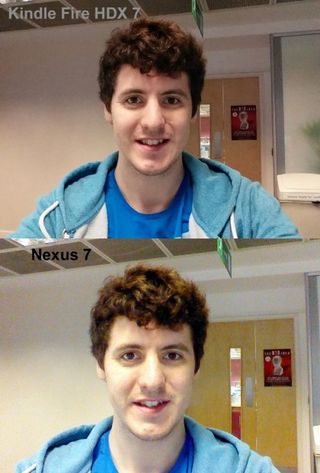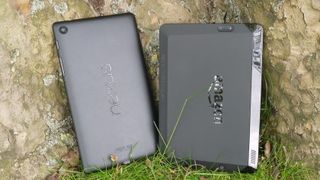Google Nexus 7 (2013) vs Amazon Kindle Fire HDX 7
The battle of the budget 7 inchers
Camera
The Google Nexus 7 comes out on top in the camera department boasting a front facing 1.2MP snapper and a rear facing 5MP lens, while the Kindle Fire HDX 7 offers just a 1.3MP camera on the front.
Google has recently given its Android camera app an overhaul and the Nexus 7 is one of the first devices to take advantage of the new look app with its oversized shutter button taking up a fifth of the screen.
It's pretty intuitive and with the option to record full HD videos too there is a decent host of features available on the Nexus 7.

Click here to see the full-res image
Images are passable, but they won't blow you away. Chances are the smartphone in your pocket will be able to take better snaps than the Nexus 7, but for the occasional photo it provides a serviceable option.
Over on the Kindle Fire HDX 7 and the camera app is extremely basic. You get a shutter key, a shortcut to the gallery and a toggle for camera and video modes.
There are no additional features to play with and shots are generally pretty grainy. You won't be taking any pictures to show off to friends and family here.
Get daily insight, inspiration and deals in your inbox
Get the hottest deals available in your inbox plus news, reviews, opinion, analysis and more from the TechRadar team.
What the front facing cameras on both tablets do provide though is the possibility for video calls using services such as Google Hangouts and Skype - and for this purpose both are adequately equipped.

Price
In terms of price there's little to separate the tablets. Both start at £199 for the 16GB, Wi-Fi only variants, although Google does charge a little more for the 32GB Nexus 7 which comes in at £239.
The 32GB Kindle Fire HDX 7 is a touch cheaper at £229, but that does include adverts displayed on the lockscreen.
If you don't want Amazon pushing you products every time your lock your Fire HDX then you can select "without special offers", which pushes the 16GB price up to £209, while the 32GB option matches the Nexus 7.
An advantage Amazon has is its 64GB option, but you'll need to part with £259 (with ads) or £269 (without ads).
Wi-Fi only models are perfect if you only really plan on using the tablet at home or at locations with a Wi-Fi network. If you're going to be out and about with your tablet though you'll want to consider a Wi-Fi + 4G LTE option, allowing you to access the internet on the move, just like on your mobile phone.
Amazon comes out on top here, with the Wi-Fi + 4G option available on all three storage models. The 16GB is £269 with ads/£279 without ads, 32GB is £299/£309 and the 64GB Kindle Fire HDX 7 with 4G connectivity is £329/£339.
You're more restricted if you want a 4G enabled Nexus 7 as only the 32GB model comes with the additional connectivity, setting you back £299.
The Nexus 7 does come unlocked, allowing you to pick up a data plan from a network of your choosing, where as the Kindle Fire HDX 7 comes locked to Vodafone.
Verdict
In short, both tablets are excellent offerings with plenty of power, luscious screens and a wealth of media available at your fingertips.
If you're looking for a slate which you can pick up and start using with minimum fuss and technical know- how then the Kindle Fire HDX 7 is the one to plump for.
Its re-mastered interface places your apps, games, books and videos front and centre for easy access and Amazon's vast libraries of content means you'll never run out of something to read, watch or play.
While the HDX 7 may have the slightly newer components under the hood, the Google Nexus 7 is the better choice for anyone who wants flexibility from their tablet.
The stock Android interface provides a wider array of options compared to Amazon's Fire OS, and you get the suite of Google apps on the Nexus 7 including the Play store which can service you with not only apps, but games, movies and books too.
There's no locked down operating system, giving you the freedom to manipulate the Nexus 7 in many ways, great for those who are more tech savvy.
- Read a full review of the Google Nexus 7 and the Amazon Kindle Fire HDX 7

John joined TechRadar over a decade ago as Staff Writer for Phones, and over the years has built up a vast knowledge of the tech industry. He's interviewed CEOs from some of the world's biggest tech firms, visited their HQs and has appeared on live TV and radio, including Sky News, BBC News, BBC World News, Al Jazeera, LBC and BBC Radio 4. Originally specializing in phones, tablets and wearables, John is now TechRadar's resident automotive expert, reviewing the latest and greatest EVs and PHEVs on the market. John also looks after the day-to-day running of the site.
